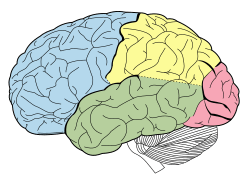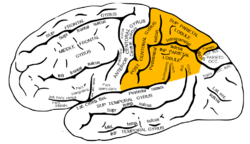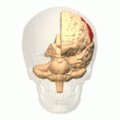Parietal lobe facts for kids
| Brain: Parietal lobe | ||
|---|---|---|
Quick facts for kids
|
||
| Principal fissures and lobes of the cerebrum viewed laterally. (Parietal lobe is shown in yellow) | ||
| Lateral surface of left cerebral hemisphere, viewed from the side. (Parietal lobe is shown in orange.) | ||
| Latin | lobus parietalis | |
| Part of | Cerebrum | |
| Artery | Anterior cerebral Middle cerebral |
|
| Vein | Superior sagittal sinus | |
The parietal lobe is a part of the brain positioned above the occipital lobe and behind the frontal lobe.
The parietal lobe brings together information from different senses, particularly spatial sense and navigation. For example, it uses input about touch, balance and the visual system. This enables the parietal cortex to map seen objects in relation to the body (into 'body coordinate positions'). This makes it possible for a person to reach out and handle objects.
The name derives from the overlying parietal bone, which is named from the Latin pariet-, = 'wall'.
Images for kids
See also
 In Spanish: Lóbulo parietal para niños
In Spanish: Lóbulo parietal para niños

All content from Kiddle encyclopedia articles (including the article images and facts) can be freely used under Attribution-ShareAlike license, unless stated otherwise. Cite this article:
Parietal lobe Facts for Kids. Kiddle Encyclopedia.



